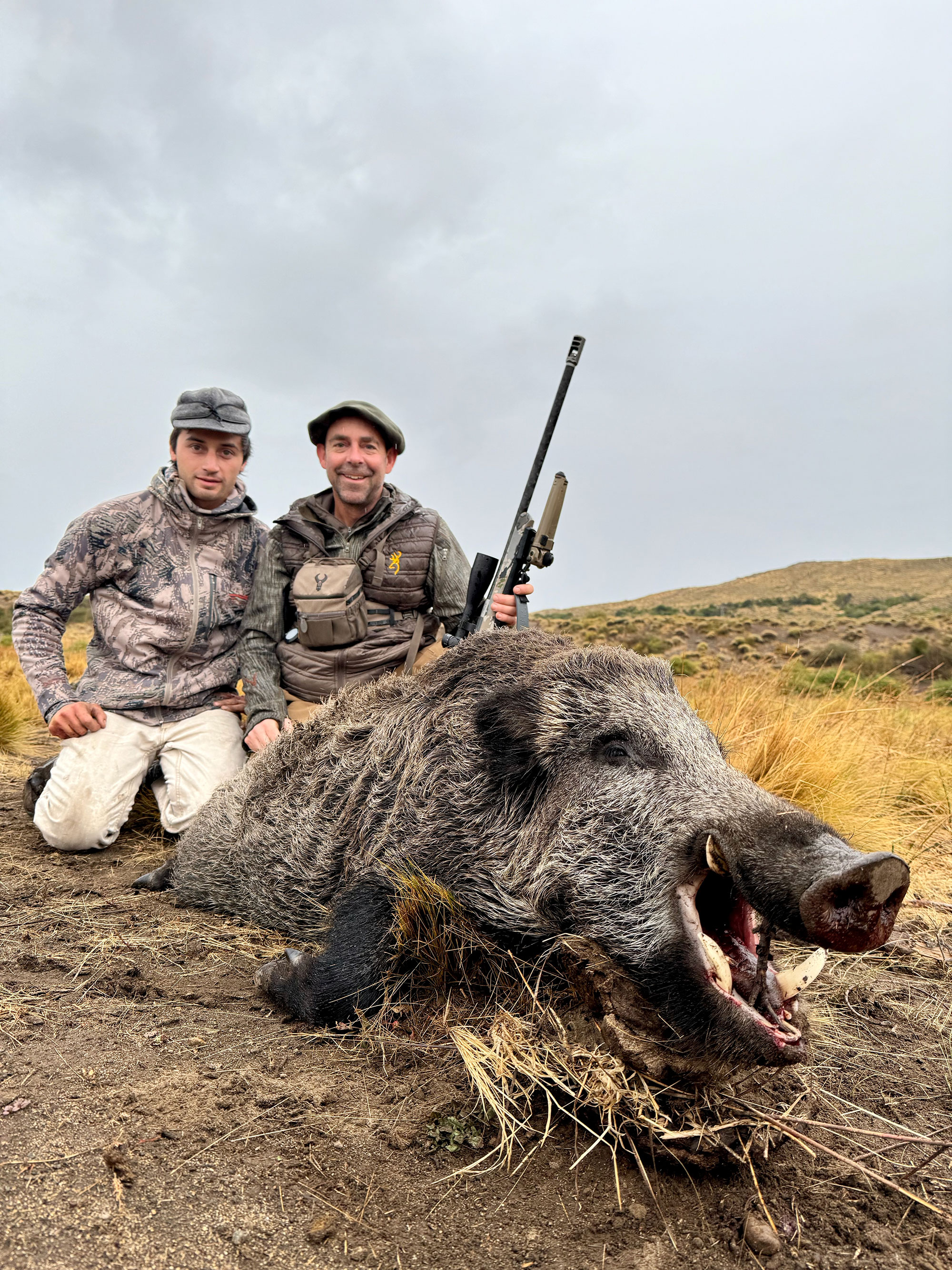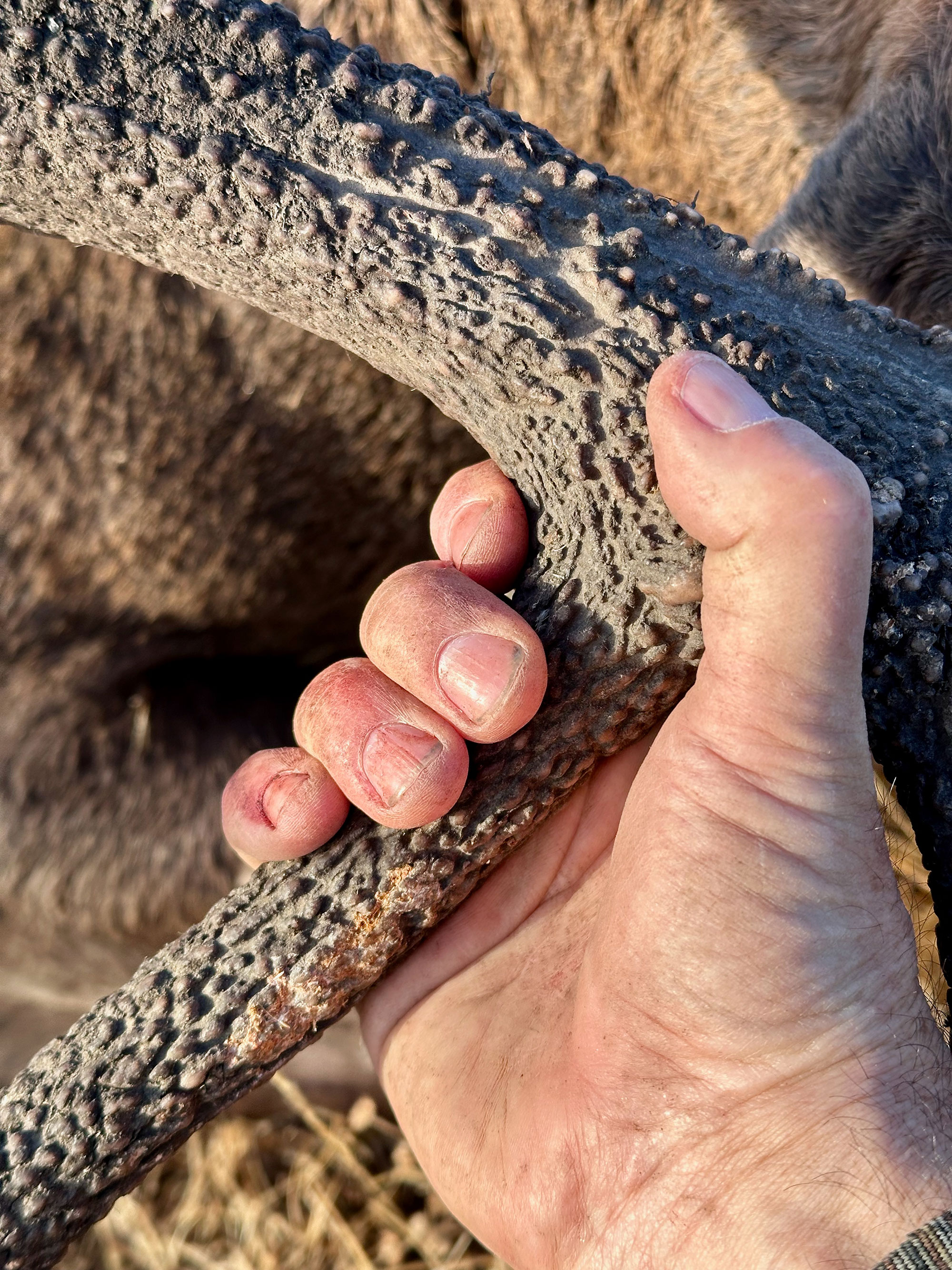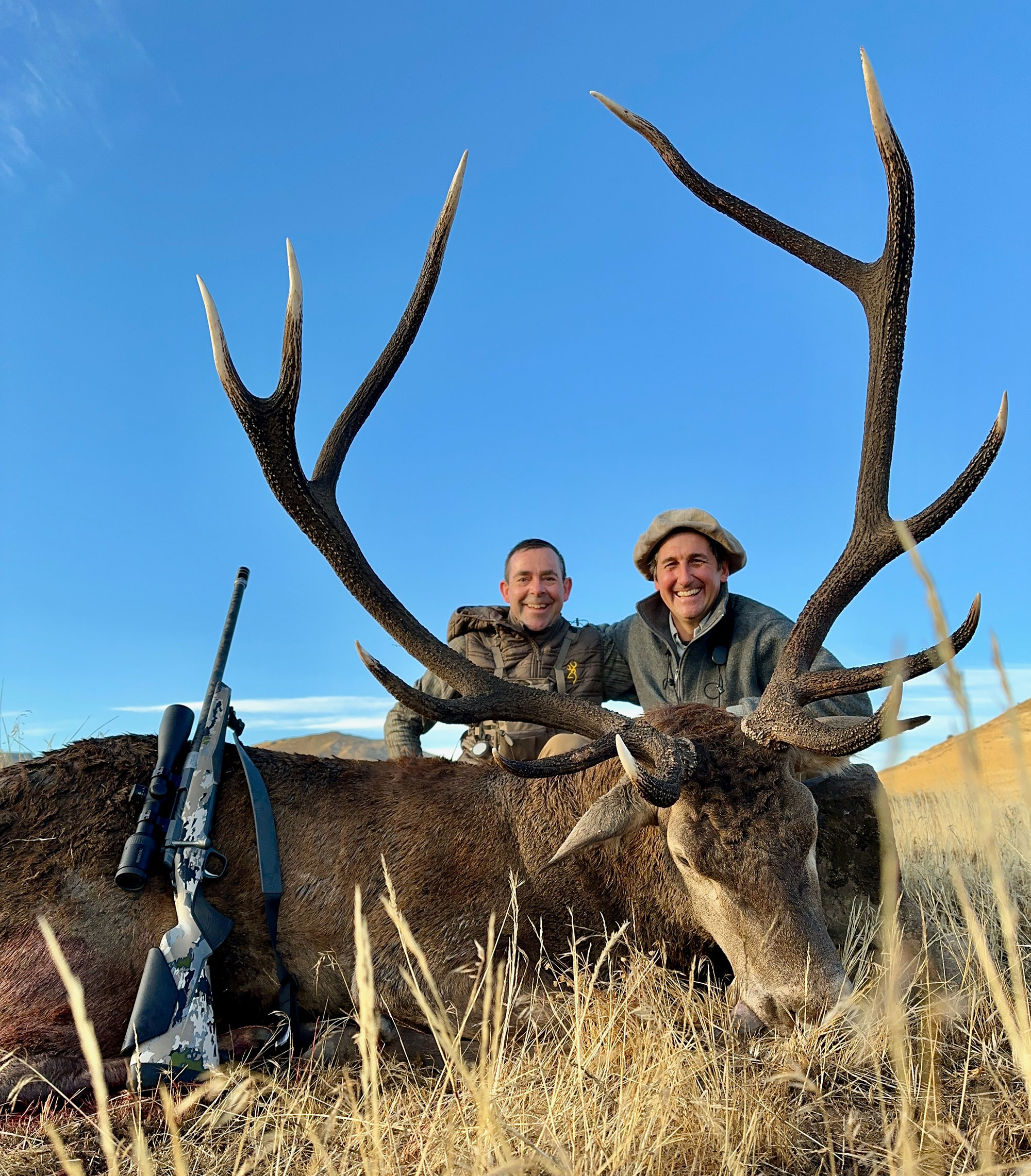The best part about belly-crawling toward a herd of rut-distracted Argentine stags, besides the tang of anticipation in the back of my throat, is the lack of both cactus and rattlesnakes. That, and the snow-capped volcano rising from the Chilean border to the west, are about the only physical reminders that this isn’t central Montana, or parts of Colorado’s Western Slope.
The bunchgrass uplands that step up to timbered foothills, the amethyst blue sky, the Herefords, and the restless wind all could be set pieces of the American West. What’s distinctly not Mountain Standard are the herds of red deer, spread out across the sprawling pampas in milling groups of a dozen to 20, each tended by a stag in peak roar. Their vocalization isn’t the tweedy, melodious bugle of rutting Rocky Mountain bull elk. Instead, it sounds like it’s coming from carnivorous cattle. Guttural, lewd, more elemental, with barks, growls, and snarls that sound cranky and carnal.
Their physical agitation is almost as aggressive as their roar. Dominant males push harems of hinds (the term for female red deer) away from satellite stags that literally sprint across the Patagonian grassland to challenge the mature stags and attempt to steal their breeding stock. Young males run wild-eyed and non-directional, unsure how to respond to the surge of testosterone or how they fit into the sorting and courting taking place all around them.
All day and night, roaring rises from mountain valleys. I’m here in late March, the fall equinox in the Southern Hemisphere, and apparently the frenzied peak of the roar, which gets even more raucous as the air cools and the sun sinks behind the serrated ridges of the high Andes.
As we glass from behind a clump of prickly guanaco bush — its nickname translates to “mother-in-law’s pillow” — my guide Adrian Meta classifies the half-dozen stags that are roaring below us, moving in and out of bunching willows on the gravel floodplain of the Rio Chimehuin. I’m using Swarovski’s EL Range binocular in the brand new 10×32 configuration; Meta has the most tortured, work-worn EL 10x42s I’ve ever seen. The rangefinder no longer works, but he notices every detail through the scratched and dented binocular.
“That one. Good length, but no heavy,” says Meta in slow, deliberate English thickened with accent. His English is better than my Spanish, but we stick to simple descriptions and extravagant hand gestures, and when either of us blank on the right word, we turn to Meta’s bilingual son, Franco, for help. “That one. Heavy, but his points are not long. And that one, he has no tops. He’s an orchid.”
I wonder how this 5×5 stag with two points on each top resembles a flower in bloom, but later I learn that he means “horqueta,” Spanish for pitchfork. Meta looks over the “orchid” one more time and mutters to Franco.
“You want to shoot him?” Franco asks me, then assures me there’s no cost. “He’s a management stag. He will never grow into a trophy and those daggers are dangerous to the other stags” he’ll fight during the rut. In addition to “orchids,” the guides are looking to remove “assassins,” mature spikes that frequently kill their sparring partner.
I decline, because I’m waiting for a stag that has it all: heavy mass, long main beams, impressive tines, and especially the classic “crown” of at least three points at the top of each main beam. That crown, which Scottish gillies say qualifies if it can hold a whisky glass in its bowl, is partly what differentiates the red stag, native to Europe, from North America’s wapiti, or elk.

Photo by Andrew McKean
Argentina’s stags arrived here from Scotland, Hungary, and what was then Czechoslovakia over a century ago. Many of their descendants reside inside game-farm enclosures and are sold as “estate” trophies that sport antlers of outlandish proportions because they are fed and penned and kept as a type of alternative livestock. That is basically the New Zealand mode of stag hunting, too. But I’m in Patagonia, in southwestern Argentina, where the ranches are immense (the one we’re hunting, Tipiliuke, is 60,000 acres), the habitat is especially conducive to large, grass-eating ungulates, and the low smooth-wire cattle fences don’t constrain their movement. These are free-range stags, which may not grow antlers as freakishly large as estate stags, but offer challenging stalking in conditions familiar to a prairie elk hunter, with cautious sneaks across open ground, shifting winds, the possibility of long rifle shots preceded by plenty of glassing with spotting scopes and binoculars.
It’s so challenging that I can’t connect with the “muy grande” stag we’re after, though we’re tuned to his distinctive deep, throaty roar. We see pieces and parts of him in the river willows, but when he finally steps into the open, to challenge a younger stag, he’s 500 yards away and it’s beyond what we’d call legal shooting light in the U.S. I won’t risk a low-odds shot at a remarkable animal.
After three days of hunting for this particular stag, passing dozens of opportunities at smaller 6-points and “orchids,” I’m humbled by the country and a little embarrassed by my selectivity.

Photo by Andrew McKea
Between intensive glassing sessions we hike into hidden kloofs and vales, and in one we catch a bristle-backed pig breaking out of cover. After getting the okay from Franco, I throw my coat and then my rifle over a guanaco bush while my hunting partner, Browning’s Shaundi Campbell, whispers the range. The Russian boar slows to a determined walk, and I hold on the point of the shoulder and drop him in his tracks with my carbon-barreled Browning X-Bolt 2 Speed.
He’s a stud, and finally I have something to report to my tagged-out buddies, who return to dinner with stories of catching 18-inch rainbows on mouse imitations skated under willow branches on the inside bends of the glittering Rio Chimehuin.
Read Next: Browning X-Bolt 2 Review
A Bonus Elk Season

Photo by Andrew McKean
Up north in elk country, we’re a half-year away from the rut. For most elk hunters, this is the season for planning, for applying for out-of-state hunts and special permits. But increasingly, it’s also the season for managing expectations. Elk hunting is changing, with longer odds for premium permits, more hunters on accessible public land, and a rising sense that one of the birthrights of rural Westerners — hunting elk every year on a general tag — is no longer available in most states.
Western big-game outfitter Dan Harrison, recognized that dynamic years ago. He transitioned some of his operations to Argentina, where he does a lively business guiding Western elk hunters to South American stags.
“I opened up Argentina because of the overflow of interest from American clients who are tired of waiting 10-15 years to draw a tag in their own state,” Harrison says. “What’s surprising is that an Argentina hunt can be cheaper than an average elk or mule deer hunt in North America with travel included.”
John Burrell’s interest in Patagonia isn’t based on economics so much as his recognition that he could offer a handful of singular, savory experiences in a week-long stay at Tipiliuke, the eponymous name of both the ranch and the lodge that serves as the base of our operation in Argentina.
Burrell’s High Adventure Company has managed the stag hunting here for more than 20 years. When Burrell first came to Patagonia, it was for its legendary fishing. But he noticed the abundant red deer, floated rivers between sparring stags, and finally inquired about hunting them. Besides a handful of Belgians who had been coming for years, stag were largely overlooked on the ranch, he was told. But when the Belgians decided they could no longer handle climbing the foothills of the Andes, Burrell joined with longtime lodge manager Kevin Tiemersma and his wife Mary Jo to accommodate stag hunters in addition to anglers, quail hunters, horseback riders, bird-watchers, skiers, and visitors who simply want to soak in the wide Patagonian sky and tour the mountain towns and nearby national parks.

Photo by Andre McKean
Burrell agrees with Harrison that there’s increasing interest in Argentina from displaced American big-game hunters who are fleeing bonus-point creep and increasing prices for guided hunts. For those who are turned off by estate stags, Tipiliuke and other free-range ranches across Patagonia offer an appealing alternative.
“This is as free-range as it gets, for better and for worse,” says Burrell. “If somebody contacts Tipiliuke and wants to talk inches of antler, I tell them this might not be the place for them. We have wonderful stags, but you can’t compare free-range hunting to estate hunting. Our stags come and go, they migrate, they live with the weather and with landowner tolerance. We might see a trophy stag one day, but then never see it again. It’s a lot like a true Western elk hunt.”
Except I haven’t been on many elk hunts where I’m handed a plate of warm empanadas and a glass of wine when I come in from the field, and where I’m reluctant to share with my wife, enduring a nasty late-winter storm back home, just how comfortable the beds at Tipiliuke are.
Hunting here isn’t cheap, but neither is it far out of reach of many American hunters who save and dream of an international hunt.
“If you budget $10,000, you’re going to be very close” to covering the costs of the hunt, any trophy fees, and travel, says Burrell. “If you do a 4-day hunt, which is typical, you’re looking at $7,500 to $8,500, which is in line with a guided elk hunt [in the States]. If you kill a really big stag, you could be looking at $10,000 or more, depending on just how big it is, because of trophy fees. Then you have domestic airfare, which is around $400, and then $400 to $500 to ship your trophies home.”
But by the night before my final day, I don’t have any inches of antlers to quantify, or trophies to ship home. Burrell asks if I want to hunt a neighbor’s ranch the following morning. After confirming it’s not a high-fence operation, I agree, not quite sure what’s ahead.
The Prince of Pasta

Photo by Andrew McKea
Tuco Matarazzo meets me at the lodge two hours before sunup, and we drive north, around the little mountain of Tipiliuke — a dormant volcano, the distinctive landform means “upside-down heart” in the local dialect — and through the little town of Junin de los Andes, where backpackers are already on the side of the road, thumbing for rides. It’s unclear to me, given our language barrier, if Tuco is my driver or my hunting guide. But it soon dawns on me that he’s both. He’s also the owner of the ranch, one of the largest in Patagonia.
Just as the morning light breaks, we pull into a cattle pasture and listen. The air is splintered with roars of rutting stags. Maybe 200 red deer are milling and shifting in the half-light, and we make a stalk on a stag far bigger than any I had seen at Tipiliuke. Its dark antlers are tall and thick, with long tines. I can’t assess its crowns, but I take Tuco’s word that he’s a trophy. I set up on shooting sticks, wait for hinds and smaller stags to clear my Swarovski Z5 scope, and send a 300-yard shot. To my astonishment, it’s a clean miss, but its intent is clear to the valley full of deer, which head to the towering hills in a frenzy.
“What do you want to do?” asks a frazzled Tuco. “We could follow, or we could leave these and go find others.”
We know there are a couple of stud stags in this group, and we’re here, so I elect to stay the course, to let the red deer run into the next valley, and follow them, knowing it will be a stout hike out of this valley. Tuco agrees so quickly I can tell that’s his preference, too.
Halfway into our hour-long climb, as the sun lights up the pampas, we stop and Tuco points down to his house, where his young children are getting ready for school. He tells me the history of this ranch, which sprawls across more than 100,000 acres and climbs nearly to the volcano we see to the west. Tuco left Patagonia for an international career as a professional polo player, then came back to take over the family ranch, work that occasionally includes guiding hunters who stay at Tipiliuke. He needs me to kill a stag before noon, he tells me, because he has bulls to ship to market.

Photo by Andrew McKean
We make a play on the red deer, which have now settled, and I’m red-faced to say I miss again, high Tuco thinks. Our hike back to the pickup seems longer than our approach, partly because we stop to shoot at a rock at 200 yards, to confirm my zero. My rifle is dead-on. Maybe because I want to talk about anything but my marksmanship, I ask: Is Tuco his given name?
“Oh no. It’s a nickname. My given name is Arturo, but when I was a kid I was so skinny that my friends called me ‘Tuco,’ which means spaghetti sauce — they said I was thin like the tomato sauce on spaghetti. It stuck because my family at the time owned a familiar brand of pasta in Argentina.”
The morning is getting on, and deer are starting to bed down, but we check out another valley on Tuco’s ranch. We glass a nice stag, maybe a little small and thin but with nice crowns. I realize I can’t be picky. I’d love to tag my first Patagonian stag, and while I don’t want to settle, I find myself in a sort of rhythm with Tuco. We share the same instincts, the same reactions to stimuli, and the same willingness to walk far and crawl on our bellies if that’s what it takes. Though we just met, it’s as though we’ve been hunting together for years. I hope to hell I don’t miss again. But, like so many other prospective stags here, this one is swallowed by the terrain.
Moments later, Tuco and I spot different interesting stags at precisely the same moment. Mine is on a ridge, going away. His is in the bottom of a wide-open bowl, tending a dozen hinds. His looks to have a higher probability of success, and together we slip into an eroded cut that will hide our approach, and while the wind isn’t great, we cut the distance to the stag in half. This landscape and hunting style reminds me precisely of stalking pronghorn antelope on the Montana prairies of my homeland, trying to be small and unnoticed in immense, featureless country.

Photo by Andrew McKean
Tuco glasses, but I’m intent on finding little cleaves and furrows in the pampas that will let us get even closer. Finally, we slink to within 370 yards. There’s nothing but open grass in front of us, and I worry the wind will send our scent to the herd any minute. Tuco gives me the classic sign of an undecided hunter: palms upward and his shoulders hunched, as if to say it’s up to me.
That’s all I need. I’d like to be closer, but I throw my pack on a little gumbo hump and settle in behind the rifle. I have time to account for wind and distance and don’t second-guess my abilities. I send it, and the trigger break feels good. The stag wheels and actually runs toward us, and after I put him down for good, I realize we’re a couple of miles from the truck.
“This is not a problem,” Tuco tells me. “It’s good to know the owner.”

Photo by Andrew McKean
With that, he disappears to collect the truck, and I have time with this remarkable animal, its antlers dark and pearled and unfortunately not crowned, its pelt a deep brownish-red, its body stocky and compact. It’s not quite as large as a mature Rocky Mountain elk, but it shares the distinctive neck hump, musky scent, and caked mud on its flanks and forelocks. This stag has been wallowing when it wasn’t tending its harem.
As I wait for Tuco and his pickup to take apart the stag, I catch movement in my periphery. It’s a small gray fox, and it sniffs the wind as it approaches, oblivious to my presence, so close at one point I could touch its head with my rifle.
When Tuco arrives, the fox vanishes, and I mention its visitation.
“Ah, you’ve met one of our few natives,” he says. “Our trout, they came from somewhere else. Our stag, they’re from elsewhere. Our boars, from Russia. Most of our people, they aren’t from here. But that fox, that’s a true Patagonian.”
We pose for pictures, and Tuco produces an immense gaucho knife and starts breaking down the stag. Some of its meat will feed his family, some will be sold. If we hurry, he will be home in time to ship some bulls. There’s nothing else he could have said that would make me feel more at home. I realize with a quiet pang, as I hold a back leg and Tuco cuts away the quarter with his knife, that I’m not nearly ready to leave this familiar exotic place.
Read the full article here




